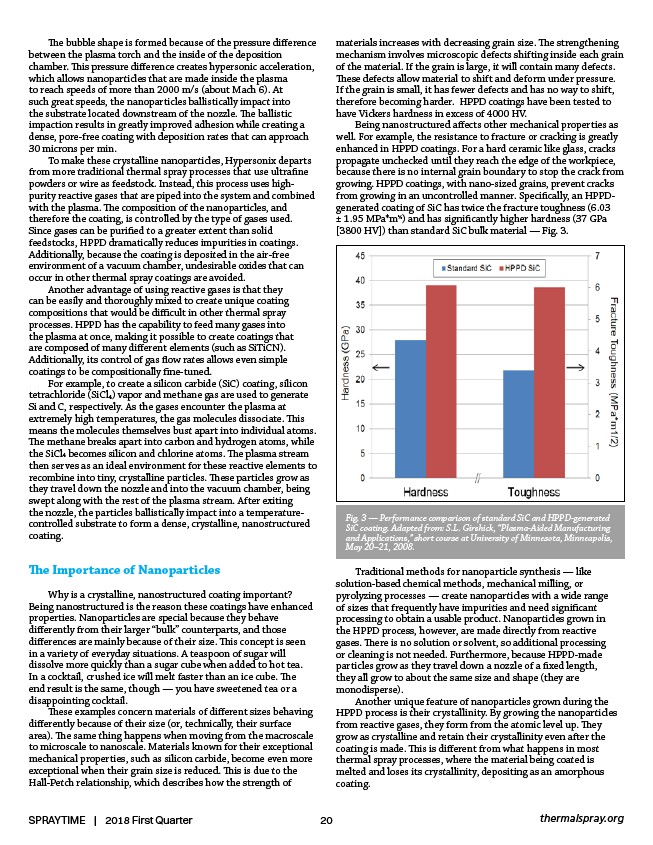
The bubble shape is formed because of the pressure difference
between the plasma torch and the inside of the deposition
chamber. This pressure difference creates hypersonic acceleration,
which allows nanoparticles that are made inside the plasma
to reach speeds of more than 2000 m/s (about Mach 6). At
such great speeds, the nanoparticles ballistically impact into
the substrate located downstream of the nozzle. The ballistic
impaction results in greatly improved adhesion while creating a
dense, pore-free coating with deposition rates that can approach
30 microns per min.
To make these crystalline nanoparticles, Hypersonix departs
from more traditional thermal spray processes that use ultrafine
powders or wire as feedstock. Instead, this process uses highpurity
reactive gases that are piped into the system and combined
with the plasma. The composition of the nanoparticles, and
therefore the coating, is controlled by the type of gases used.
Since gases can be purified to a greater extent than solid
feedstocks, HPPD dramatically reduces impurities in coatings.
Additionally, because the coating is deposited in the air-free
environment of a vacuum chamber, undesirable oxides that can
occur in other thermal spray coatings are avoided.
Another advantage of using reactive gases is that they
can be easily and thoroughly mixed to create unique coating
compositions that would be difficult in other thermal spray
processes. HPPD has the capability to feed many gases into
the plasma at once, making it possible to create coatings that
are composed of many different elements (such as SiTiCN).
Additionally, its control of gas flow rates allows even simple
coatings to be compositionally fine-tuned.
For example, to create a silicon carbide (SiC) coating, silicon
tetrachloride (SiCl4) vapor and methane gas are used to generate
Si and C, respectively. As the gases encounter the plasma at
extremely high temperatures, the gas molecules dissociate. This
means the molecules themselves bust apart into individual atoms.
The methane breaks apart into carbon and hydrogen atoms, while
the SiCl4 becomes silicon and chlorine atoms. The plasma stream
then serves as an ideal environment for these reactive elements to
recombine into tiny, crystalline particles. These particles grow as
they travel down the nozzle and into the vacuum chamber, being
swept along with the rest of the plasma stream. After exiting
the nozzle, the particles ballistically impact into a temperaturecontrolled
substrate to form a dense, crystalline, nanostructured
coating.
The Importance of Nanoparticles
Why is a crystalline, nanostructured coating important?
Being nanostructured is the reason these coatings have enhanced
properties. Nanoparticles are special because they behave
differently from their larger “bulk” counterparts, and those
differences are mainly because of their size. This concept is seen
in a variety of everyday situations. A teaspoon of sugar will
dissolve more quickly than a sugar cube when added to hot tea.
In a cocktail, crushed ice will melt faster than an ice cube. The
end result is the same, though — you have sweetened tea or a
disappointing cocktail.
These examples concern materials of different sizes behaving
differently because of their size (or, technically, their surface
area). The same thing happens when moving from the macroscale
to microscale to nanoscale. Materials known for their exceptional
mechanical properties, such as silicon carbide, become even more
exceptional when their grain size is reduced. This is due to the
Hall-Petch relationship, which describes how the strength of
materials increases with decreasing grain size. The strengthening
mechanism involves microscopic defects shifting inside each grain
of the material. If the grain is large, it will contain many defects.
These defects allow material to shift and deform under pressure.
If the grain is small, it has fewer defects and has no way to shift,
therefore becoming harder. HPPD coatings have been tested to
have Vickers hardness in excess of 4000 HV.
Being nanostructured affects other mechanical properties as
well. For example, the resistance to fracture or cracking is greatly
enhanced in HPPD coatings. For a hard ceramic like glass, cracks
propagate unchecked until they reach the edge of the workpiece,
because there is no internal grain boundary to stop the crack from
growing. HPPD coatings, with nano-sized grains, prevent cracks
from growing in an uncontrolled manner. Specifically, an HPPDgenerated
coating of SiC has twice the fracture toughness (6.03
± 1.95 MPa*m½) and has significantly higher hardness (37 GPa
3800 HV) than standard SiC bulk material — Fig. 3.
Fig. 3 — Performance comparison of standard SiC and HPPD-generated
SiC coating. Adapted from: S.L. Girshick, “Plasma-Aided Manufacturing
and Applications,” short course at University of Minnesota, Minneapolis,
May 20–21, 2008.
Traditional methods for nanoparticle synthesis — like
solution-based chemical methods, mechanical milling, or
pyrolyzing processes — create nanoparticles with a wide range
of sizes that frequently have impurities and need significant
processing to obtain a usable product. Nanoparticles grown in
the HPPD process, however, are made directly from reactive
gases. There is no solution or solvent, so additional processing
or cleaning is not needed. Furthermore, because HPPD-made
particles grow as they travel down a nozzle of a fixed length,
they all grow to about the same size and shape (they are
monodisperse).
Another unique feature of nanoparticles grown during the
HPPD process is their crystallinity. By growing the nanoparticles
from reactive gases, they form from the atomic level up. They
grow as crystalline and retain their crystallinity even after the
coating is made. This is different from what happens in most
thermal spray processes, where the material being coated is
melted and loses its crystallinity, depositing as an amorphous
coating.
SPRAYTIME | 2018 First Quarter 20 thermalspray.org